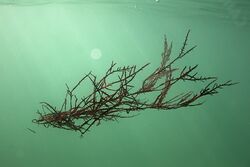Biology:Gelidium sesquipedale
| Gelidium sesquipedale | |
|---|---|

| |
| Gelidium sesquipedale | |
| Scientific classification Error creating thumbnail: Unable to save thumbnail to destination
| |
| (unranked): | Archaeplastida |
| Division: | Rhodophyta |
| Class: | Florideophyceae |
| Order: | Gelidiales |
| Family: | Gelidiaceae |
| Genus: | Gelidium |
| Species: | G. sesquipedale
|
| Binomial name | |
| Gelidium sesquipedale (Clemente) Thuret 1876
| |
| Synonyms | |
| |
Gelidium sesquipedale is a commercially important species of red algae. It is a thalloid seaweed, branching on a single axis. A clonal species, it grows in stands on rocky bottoms in the subtidal zone in areas with high water movement and exposed to wave action.
Distribution
It is found in the Atlantic Ocean between the coasts of the Great Britain and Mauritania. However, the most important concentrations of the species are found along the rocky coasts of France , Northern Spain , Portugal and Morocco.
Commercial use
The species is an important commercial source of agar. The species are harvested either by commercial divers in Portugal and Morocco whereas in Spain and France floating detached thalli and beach coast are gathered. The former method may not be as sustainable however, yields and populations are in decline/have collapsed in Portugal as of the 2000s.[1] Populations are also in decline in Morocco, the world's leading producer, leading to trade restrictions and to shortages of agar on the world market, notably for laboratory-grade product.[2]
More recently, the species has started to be used in cosmetics, as a skin care and sunscreen ingredient.[3][4] It contains metabolites such as carotenoids, peptides, and mycosporine-like amino acids,[5] with antioxidant properties.
References
- ↑ Marques, A; Imaginario, S; Rodrigues, H; Santos, R. "Portuguese Macroalgal Industry". http://www.netalgae.eu/uploadedfiles/Portugal.pdf.
- ↑ Callaway, Ewen (2015). "Lab staple agar hit by seaweed shortage". Nature 528 (7581): 171–172. doi:10.1038/528171a. PMID 26659158. http://www.nature.com/news/lab-staple-agar-hit-by-seaweed-shortage-1.18970. Retrieved 2016-02-26.
- ↑ "Laboratories - Laboratoires de Biarritz" (in en-US). http://www.laboratoires-biarritz.fr/en/laboratories/#nos-recherches.
- ↑ "Algues - Thalgo". http://www.thalgo.fr/algues/gelidium-sesquipedale.14-G.html.
- ↑ Aguilera, Arjona Jose; De, La Coba Luque Francisca; Lopez, Figueroa Felix (8 Mar 2007), Use of a mixture of mycosporin-type amino acids (asterin 330 + palythine) as an antioxidant, https://www.google.com/patents/WO2007026037A2, retrieved 2016-02-26
Wikidata ☰ Q5876636 entry
 |

